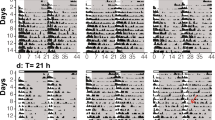Abstract
Using in vivo microdialysis, effects of retinally perceived light on pineal melatonin release and its rhythmicity was examined in the pigeon. In the first experiment, light-induced suppression of pineal melatonin release was studied. Although light given to the whole body during the dark strongly suppressed pineal melatonin release to a daytime level, light exclusively delivered to the eyes did not remarkably inhibit melatonin release. In the second experiment, in order to determine whether retinally perceived light has phase-shifting effects on pineal melatonin rhythms, pigeons were given a single light pulse of 2 h at circadian time (CT) 18 and the phases of the second cycle after the light pulse were compared with those of control pigeons without the light pulse. In this experiment, phase advances of pineal melatonin rhythms were observed when the light was given to the whole body but not when only the eyes were illuminated. In a third experiment, after entrainment to light-dark 12:12 (LD 12:12) cycles, birds whose heads were covered with black tapes were transferred into constant light (LL) conditions and only the eyes were exposed to new LD cycles for 7 days (the phase was advanced by 6 h from the previous cycles) using a patching protocol. This procedure, however, could not entrain pineal melatonin rhythms to the retinal LD cycles. These results indicate that the eyes are not essential for photic regulation of pineal melatonin release and its rhythmicity in the pigeon.
Similar content being viewed by others
Abbreviations
- CT :
-
circadian time
- LD :
-
light-dark
- LL :
-
constant light
- SCN :
-
suprachiasmatic nucleus
- LLdim :
-
constant dim light
- NE :
-
norepinephrine
- SCG :
-
superior cervical ganglia
- WB :
-
whole body
- E :
-
eye
- EX :
-
extraretina
- C :
-
control
References
Barrett RK, Underwood H (1991) Retinally perceived light can entrain the pineal melatonin rhythm in Japanese quail. Brain Res 563:87–93
Barrett RK, Underwood H (1992) The superior cervical ganglia are not necessary for entrainment or persistence of the pineal melatonin rhythm in Japanese quail. Brain Res 569:249–254
Cassone VM (1991) Melatonin and suprachiasmatic nucleus function. In: Klein DC, Moore RY, Reppert SM (eds) Suprachiasmatic nucleus, the mind's clock. Oxford University Press, New York Oxford, pp 309–323
Cassone VM, Menaker M (1983) Sympathetic regulation of chicken pineal rhythms. Brain Res 272:311–317
Cassone VM, Menaker M (1984) Is the avian circadian system a neuroendocrine loop? J Exp Zool 232:539–549
Chabot CC, Menaker M (1992) Effects of physiological cycles of infused melatonin on circadian rhythmicity in pigeons. J Comp Physiol A 170:615–622
Collin JP (1979) Recent advances in pineal cytochemistry. Evidence of the production of indolamines and proteinaceous substances by rudimentary photoreceptor cells and pinealocytes of amniota. In: Ariëns Kappers J, Pëvet P (eds) The pineal gland of vertebrates including man (Progress in Brain Research, vo152). Elsevier, Amsterdam, pp 271–295
Ebihara S, Uchiyama K, Oshima I (1984) Circadian organization in the pigeon, Columba livia: the role of the pineal organ and the eye. J Comp Physiol A 154:59–69
Ebihara S, Oshima I, Yamada H, Goto M, Sato K (1987) Circadian organization in the pigeon. In: Hiroshige T, Honma KS (eds) Comparative aspects of circadian clocks. Hokkaido Univ Press, Sapporo, pp 84–94
Gwinner E (1989) Melatonin in the circadian system of birds: model of internal resonance. In: Hiroshige T, Honma KS (eds) Circadian clocks and ecology. Hokkaido Univ Press, Sapporo, pp 127–145
Hasegawa M, Ebihara S (1992) Circadian rhythms of pineal melatonin release in the pigeon measured by in vivo microdialysis. Neuroscis Lett 148:89–92
Menaker M, Keatts H (1968) Extraretinal light perception in the sparrow. II. Photoperiodic stimulation of testis growth. Proc Natl Acad Sci USA 60:146–151
Menaker M, Roberts R, Elliott J, Underwood H (1970) Extraretinal light perception in the sparrow. III. The eyes do not participate in photoperiodic photoreception. Proc Natl Acad Sci USA 67:320–325
Oshima I, Yamada H, Sato K, Ebihara S (1987) The phase relationship between the circadian rhythms of locomotor activity and circulating melatonin in the pigeon (Columba livia). Gen Comp Endocrinol 67:409–414
Oshima I, Yamada H, Goto M, Sato K, Ebihara S (1989) Pineal and retinal melatonin is involved in the control of circadian locomotor and body temperature rhythms in the pigeon. J Comp Physiol A 166:217–226
Owman C, Rüdeberg C, Ueck M (1970) Fluoreszenzmikroskopischer Nachweis biogener Monoamine in der Epiphysis cerebri von Rana esculenta und Rana pipiens. Z Zellforsch 111:550–558
Reiter RJ (1991) Pineal melatonin: cell biology of its synthesis and of its physiological interactions. Endocrine Rev 12:151–180
Sato T, Wake K (1983) Innervation of the avian pineal organ: a comparative study. Cell Tissue Res 233:237–264
Takahashi JS, Murakami N, Nikaido SS, Pratt BL, Robertson LM (1989) The avian pineal, a vertebrate model system of the circadian oscillator: cellular regulation of circadian rhythms by light, second messengers, and macromolecular synthesis. Recent Prog Horm Res 45:279–352
Taniguchi M, Murakami N, Nakamura H, Nasu T, Shinohara S, Etoh T (1993) Melatonin release from pineal cells of diurnal and nocturnal birds. Brain Res 620:297–300
Underwood H, Siopes T (1984) Circadian organization in Japanese quail. J Exp Zool 232:557–566
Yamada H, Oshima I, Sato K, Ebihara S (1988) Eoss of the circadian rhythms of locomotor activity, food intake, and plasma melatonin concentration induced by constant bright light in the pigeon (Columba livia). J Comp Physiol A 163:459–463
Zatz M, Mullen DA (1988) Norepinephrine, acting via adenylate cyclase, inhibits melatonin output but does not phase-shift the pacemaker in cultured chick pineal cells. Brain Res 450:137–143
Author information
Authors and Affiliations
Rights and permissions
About this article
Cite this article
Hasegawa, M., Adachi, A., Yoshimura, T. et al. Retinally perceived light is not essential for photic regulation of pineal melatonin rhythms in the pigeon: studies with microdialysis. J Comp Physiol A 175, 581–586 (1994). https://doi.org/10.1007/BF00199479
Accepted:
Issue Date:
DOI: https://doi.org/10.1007/BF00199479




